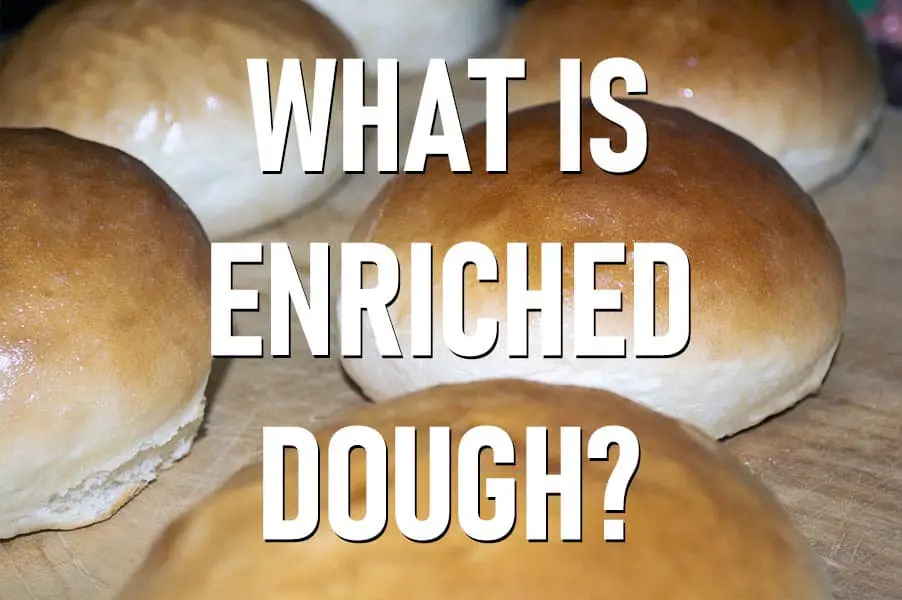An enriched dough is likely the dough that makes the type of bread most folks in the U.S. and many regions around the globe associate with homemade bread. At least, the peeps we run with tend to agree.
Enriched dough is made with rich ingredients like oil, butter, milk, eggs, and sugar. Such ingredients enhance flavor and make the texture of bread soft and fluffy. Common varieties of bread made from enriched doughs include rolls, sweetbreads, croissants, and brioche.
Bread, in our neck of the woods, is the pinnacle of every holiday feast. Not the turkey or the ham. After all, turkey and ham are only there to be turned into a sandwich on a roll. Right?
And gravy starts out on potatoes but come on, we all know it’s getting sopped up with soft fluffy bread. And when someone walks in the door with homemade rolls everyone swoons. Right? Or is that just our family?
It’s not just holiday bread though, most regularly consumed bread is enriched in some way shape or form because people tend to enjoy enriched dough more than lean dough (we have a post on lean dough if you’re curious about that). It is called enriched or enhanced for a reason.
Hamburger buns, hotdog buns, pizza dough, rolls, sandwich bread, tortillas, and flatbread, are all examples of enriched dough.
It’s possible to make some of these varieties without being enriched, like pizza dough for example. But if you want a soft crust, you’re going to need fat.
Common Enriched Breads and Their Ingredients
- Hamburger Buns: 420 grams flour, 227grams water, 1 large egg, 50 grams sugar, 1 1/4 teaspoons salt, 1 tablespoon yeast
- Hotdog Buns: Same as hamburger buns, just shaped differently.
- Pizza Dough: 400 grams flour, 280g water, 1 1/4 teaspoons salt, 25g olive oil, 1 teaspoon yeast
- Rolls: 400 grams Flour, 225 grams milk, 50 grams water, 20 grams butter, 10 grams sugar, 1 tablespoon yeast
- Sandwich Bread: 480 Grams Flour, 340 grams water, 30 grams honey, 1 1/2 teaspoon salt, 28 grams butter, 30 grams powdered milk, 2 1/4 teaspoons yeast
- Tortillas: 300 grams four, 50 grams shortening, 220 grams water, 1/2 teaspoon salt, 1 teaspoon baking powder
- Flatbread (Naan): 400 grams flour, 28 grams butter, 100 grams milk, 180 grams yogurt, 1 1/4 teaspoon salt, 1 teaspoon baking powder, 2 teaspoons instant yeast
How Does Enriched Ingredients Impact Hydration?
This is a good question, and the answer can sound a bit like splitting hairs. So stick with me.
Fats are typically not considered to be water/hydrating elements in a recipe. This has to do with how hydration impacts gluten development. Flour absorbs water, and essentially gluten is formed through that process. Even though oil is a liquid, it is not water and therefore is not absorbed by flour in the same way that water is.
So it is important to remember that hydration levels of dough are primarily used to impact gluten. It is true that it does impact other aspects, especially the moisture levels in bread, but for the most part hydration levels are largely based on how “thirsty” a four is. And, the protein in flour (which becomes gluten) is often the major player in how “thirsty” flour is. The more protein the more thirsty a flour is.
There are other factors like how coarse flour is ground, but generally speaking protein is the key player.
So when a recipe is written in baker’s percentage (you can learn all about what that is if you’re not sure, in our post over here) the hydration level is strictly speaking toward water content not the liquid content. Oil being a liquid without water, as noted above, is not factored into the hydration level.
But this is where it starts to sound like splitting hairs. Honey and butter have water in them, and so do eggs. To be really accurate on your hydration levels, you’d need to keep track of/remember the water content of each ingredient you use (we put a list together for you below). Then, you’d need to account for that specific weight of water in your hydration percentages. Many home bakers never get that involved in a recipe, but if you’re really into the science, and not just the art of bread making then you might want to track every little detail.
Fat, Water, and Sugar Ratios For Enriched Dough Ingredients
| Fat | Water | Sugar | Source | |
| Butter | 80% | 15 % | 0% | Link |
| Milk | 4% | 88% | 5% | Link |
| Honey | 0% | 17% | 80 % | Link |
| Egg | 10% | 75% | Trace | Link |
| Shortening | 100% | 0% | 0% | Link |
| Canola Oil | 100% | 0% | 0% | Link |
| Olive Oil | 100% | Trace | 0% | Link |
| Yogurt | 5% | 81% | 4% | Link |
For the most part, bakers consider the higher water content ingredients to be “water” or hydration ingredients. So that would mean yogurt, eggs and milk are most typically counted into the hydration. Which means water levels are decreased to compensate for the other ingredients.
Some bakers consider butter and honey into their baking as hydration but most do not. The caveat would be if the baker was using a high amount of either of them, then they would consider them as a water in their recipe. For example, brioche has a high amount of eggs and butter and very little water. The eggs are usually counted as water anyway, but butter at the level it is added in a brioche impacts hydration at that point. Which is why some brioche recipes do not add water at all.

